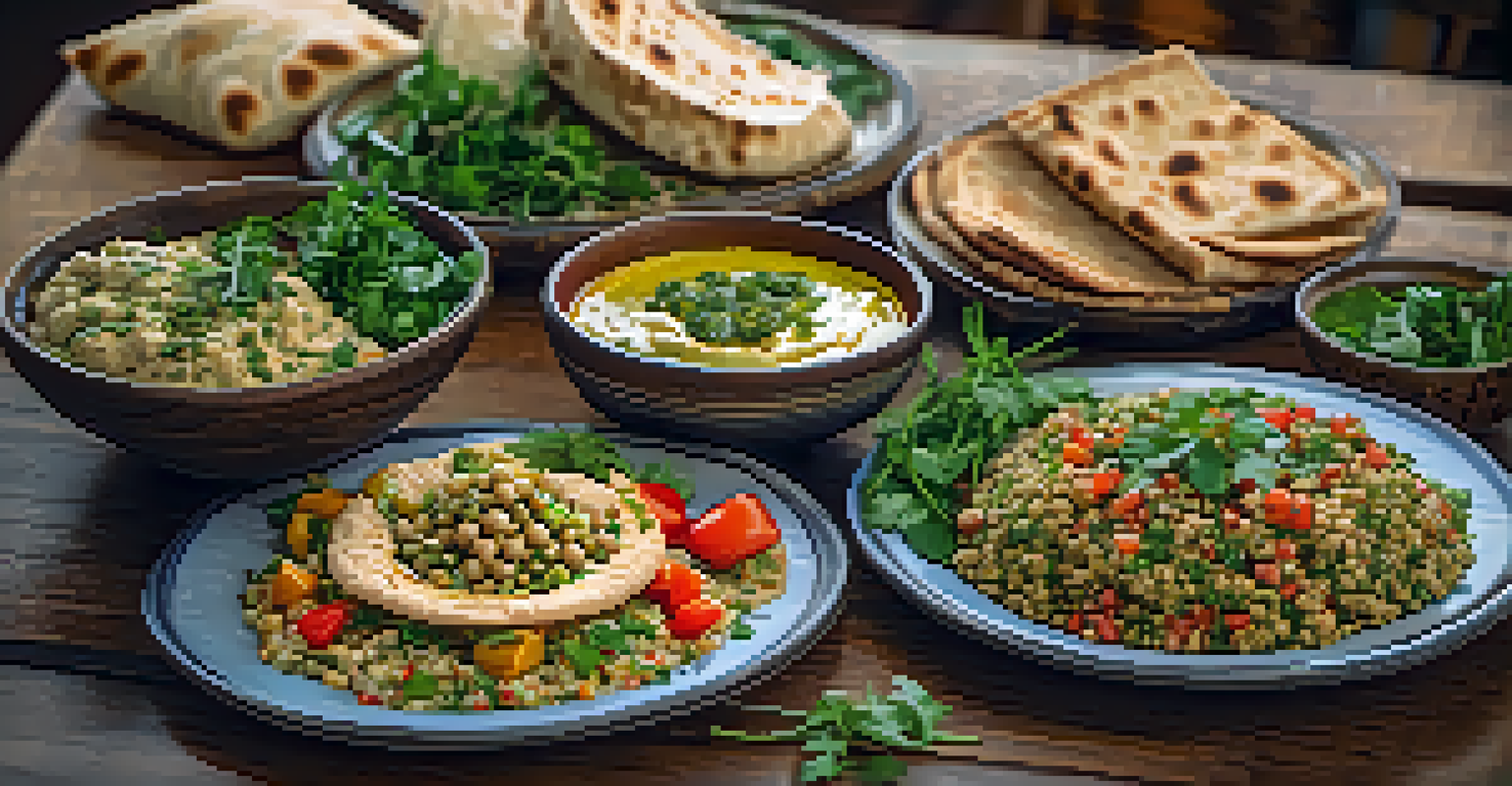The Influence of Middle Eastern Cultures on California Cuisine

A Melting Pot: California's Culinary Landscape
California is often celebrated for its rich culinary diversity, serving as a melting pot where various cultures collide. This vibrant food scene owes a lot to the influence of Middle Eastern cultures, which have brought unique flavors and cooking techniques to the Golden State. From the bustling streets of Los Angeles to the farmers' markets in San Francisco, the essence of Middle Eastern cuisine can be tasted everywhere.
Food is our common ground, a universal experience.
The fusion of Middle Eastern spices and ingredients into California cuisine is not just a trend; it's a reflection of the state's multicultural identity. As immigrants from countries like Lebanon, Iran, and Turkey arrived, they introduced traditional dishes that piqued the interest of local chefs and food enthusiasts alike. This blending of culinary practices has sparked a movement toward global flavors in everyday dining.
Moreover, the emphasis on fresh, locally sourced ingredients in California aligns beautifully with Middle Eastern cooking, which often highlights vegetables, grains, and legumes. This shared philosophy has resulted in a delightful interplay where both cuisines enhance and elevate each other, creating dishes that are both innovative and rooted in tradition.
Spices that Speak: The Role of Seasoning
One of the most significant contributions of Middle Eastern cuisine to California is the use of spices. Ingredients like za'atar, sumac, and saffron have found their way into many California dishes, adding depth and complexity. These spices not only enhance flavor but also invite diners to explore new taste experiences that go beyond the typical.

For example, za'atar has become a popular seasoning for everything from grilled meats to roasted vegetables. This herb blend, which often includes thyme, sesame seeds, and sumac, adds an earthy and tangy twist that complements California’s fresh produce. Chefs are increasingly experimenting with these spices, creating dishes that resonate with both tradition and modernity.
Culinary Fusion in California
California's diverse food scene blends Middle Eastern flavors with local ingredients, showcasing a rich multicultural identity.
By integrating these bold flavors into their menus, California chefs are not only honoring Middle Eastern culinary practices but also introducing them to a wider audience. This cross-pollination of flavors encourages diners to step out of their comfort zones and embrace a more adventurous approach to food.
The Rise of Middle Eastern Restaurants
In recent years, there has been a significant rise in Middle Eastern restaurants across California, showcasing the growing popularity of this rich cuisine. From upscale dining establishments to casual eateries, these restaurants offer a variety of dishes that highlight the diversity within Middle Eastern food. This boom reflects a broader trend where diners seek authentic experiences and flavors.
The cultural exchange that happens through food is the sweetest part of life.
Many of these restaurants focus on traditional recipes while adding a California twist. For instance, you might find a shawarma wrap made with locally sourced vegetables or a falafel burger that caters to the plant-based crowd. This creative fusion not only makes Middle Eastern cuisine more accessible but also illustrates the adaptability of these age-old recipes.
As the demand for Middle Eastern food continues to increase, so does the opportunity for chefs to innovate and experiment. This growth is not just beneficial for the restaurant industry; it also fosters cultural exchange, allowing Californians to learn about and appreciate Middle Eastern traditions through food.
Farmers' Markets: A Hub for Middle Eastern Ingredients
California's farmers' markets are a treasure trove of fresh produce, and they play a crucial role in connecting Middle Eastern flavors with local cuisine. Many market vendors offer ingredients that are staples in Middle Eastern cooking, such as pomegranates, eggplants, and various herbs. This accessibility encourages home cooks to experiment with these ingredients and try their hand at Middle Eastern recipes.
Moreover, the popularity of Mediterranean diets, which often emphasize fruits, vegetables, and whole grains, aligns perfectly with the offerings at these markets. Shoppers can easily find items like bulgur wheat, lentils, and fresh herbs, which are essential for crafting traditional Middle Eastern dishes. This availability empowers individuals to incorporate these flavors into their everyday meals.
Growing Popularity of Middle Eastern Food
The rise of Middle Eastern restaurants and street food reflects a growing interest in authentic flavors and innovative dishes in California.
As chefs and home cooks alike embrace these fresh ingredients, they create a fusion of culinary traditions. This not only results in delicious meals but also fosters a greater appreciation for the rich tapestry of flavors that Middle Eastern cultures contribute to California's food landscape.
Vegetarian and Vegan Influences
Middle Eastern cuisine is renowned for its vegetarian and vegan options, making it a natural fit for California's health-conscious food culture. Dishes like hummus, tabbouleh, and baba ghanoush are not only delicious but also packed with nutrients, appealing to those who prioritize plant-based diets. This alignment has encouraged the proliferation of Middle Eastern-inspired vegetarian and vegan dishes across California.
Many California restaurants have adopted and adapted these traditional recipes to cater to a growing audience that seeks healthy, flavorful options. For instance, a classic falafel might be served in a grain bowl with quinoa, or a traditional lentil soup could be reimagined with California-grown vegetables. This creative approach keeps the essence of Middle Eastern cuisine alive while making it relevant to modern diners.
As a result, Middle Eastern flavors are woven into the fabric of California's culinary identity, showcasing how cultural influences can lead to healthier, innovative dining experiences. The celebration of plant-based foods goes hand in hand with the rich history of Middle Eastern cooking, creating a win-win situation for food lovers everywhere.
Street Food Culture: A Taste of the Middle East
Street food has become a staple of California's diverse food culture, and Middle Eastern fare is no exception. Food trucks and street vendors serving dishes like shawarma, kebabs, and falafel have gained immense popularity, offering quick, flavorful options for those on the go. This accessibility has introduced many Californians to the vibrant flavors of Middle Eastern cuisine.
The casual nature of street food allows for a more relaxed dining experience, where people can enjoy their meals while exploring bustling neighborhoods. Many vendors take pride in using high-quality ingredients and traditional cooking methods, ensuring that the authenticity of the dishes shines through. This commitment to quality helps foster a deeper appreciation for the culinary traditions behind these meals.
Cultural Celebrations Through Food
Cultural festivals in California highlight Middle Eastern cuisine, fostering community appreciation and cultural exchange through food.
As food culture continues to evolve, the presence of Middle Eastern street food has sparked interest in exploring more diverse offerings. This excitement encourages food lovers to venture beyond their usual favorites and discover new tastes, further enriching California's already dynamic culinary landscape.
Celebrating Cultural Festivals and Food Events
California is home to numerous cultural festivals that celebrate the rich heritage of its diverse population, and food plays a central role in these events. Middle Eastern festivals often showcase traditional dishes, inviting attendees to experience the flavors and aromas that define the cuisine. These gatherings not only promote cultural understanding but also highlight the culinary contributions of Middle Eastern communities.
Events like the Los Angeles Arab Festival and the San Francisco Arab Film Festival often feature food stalls that serve everything from baklava to grilled lamb. These festivals serve as a platform for local chefs and home cooks to share their culinary skills and showcase their cultural heritage. Attendees can engage with the food, learn about its significance, and enjoy a taste of Middle Eastern culture.

By participating in these cultural celebrations, Californians gain a deeper appreciation for the history and traditions behind the food they enjoy. This exchange fosters a sense of community and highlights the importance of preserving culinary heritage, ensuring that the rich flavors of Middle Eastern cuisine continue to thrive in California.